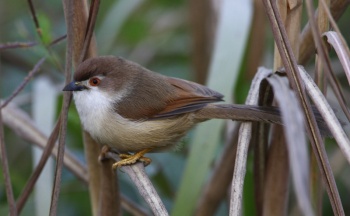(distribution) |
(completed) |
||
| Line 3: | Line 3: | ||
;[[:Category:Chrysomma|Chrysomma]] sinense | ;[[:Category:Chrysomma|Chrysomma]] sinense | ||
==Identification== | ==Identification== | ||
| − | + | 18 - 23cm. A brown, long-tailed babbler. | |
| + | * Short stout black bill | ||
| + | * Orange-yellow eye with broad orange eye-ring | ||
| + | * White lores, eyebrow, throat and brest | ||
| + | * Long, rufous tail | ||
| + | * Brown above, creamy below | ||
| + | Juveniles are much paler and more rufous above, have a browner bill and darker eyes. | ||
| + | ====Similar species==== | ||
| + | Could be confused with [[Jerdon's Babbler]], [[Slender-billed Babbler]] or [[Jungle Prinia]]. | ||
==Distribution== | ==Distribution== | ||
South [[Asia]]. Found on the Indian Subcontinent ([[Pakistan]], [[India]], [[Nepal]], [[Sri Lanka]], [[Bangladesh]]) and east over [[Burma]] to [[Thailand]], [[Laos]], [[Vietnam]] and southern [[China]].<br /> | South [[Asia]]. Found on the Indian Subcontinent ([[Pakistan]], [[India]], [[Nepal]], [[Sri Lanka]], [[Bangladesh]]) and east over [[Burma]] to [[Thailand]], [[Laos]], [[Vietnam]] and southern [[China]].<br /> | ||
| Line 14: | Line 22: | ||
* ''C. s. sinense'' in northeast [[India]] south of the river Brahmaputra, in [[Bangladesh]], [[Burma]], [[Thailand]], southern [[China]], [[Laos]] and [[Vietnam]] | * ''C. s. sinense'' in northeast [[India]] south of the river Brahmaputra, in [[Bangladesh]], [[Burma]], [[Thailand]], southern [[China]], [[Laos]] and [[Vietnam]] | ||
==Habitat== | ==Habitat== | ||
| − | Open grass and scrubland. | + | Open grass and scrubland, secondary growth, thorn-jungle, tamarisks, edges of cultivation, reedbeds, fernlands. Usually in the lowlands up to 1500m. |
==Behaviour== | ==Behaviour== | ||
| + | Feeds on caterpillars, grasshoppers and other insects. Takes also spiders, berries and nectar.<br /> | ||
| + | Clings to twigs and reed stems sideways or upside-down like a [[:Category:Parulidae|tit]]. Seldom on ground. Seen in pairs or outside the breeding season in small groups, often associated with [[:Category:Prinia|Prinias]].<br /> | ||
| + | Breeding season from March to November in most of its range. The nest is a small, cone-shaped cup made of coarse grass, fibrous bark strips, dry plant fibres and bamboo leaves. It's suspended between upright stems of reeds, grasses, sugar cane or monsoon plants or wedged in a small tree, shrub or bush. Lays 3 - 5 eggs.<br /> | ||
| + | Resident species. | ||
==References== | ==References== | ||
#{{Ref-Clements6thDec08}}#{{Ref-HBWVol12}}#{{Ref-RasmussenAnderton05}} | #{{Ref-Clements6thDec08}}#{{Ref-HBWVol12}}#{{Ref-RasmussenAnderton05}} | ||
| Line 24: | Line 36: | ||
| − | [[Category:Birds]] [[Category:Chrysomma | + | [[Category:Birds]] [[Category:Chrysomma]] |
Revision as of 17:23, 20 July 2009
- Chrysomma sinense
Identification
18 - 23cm. A brown, long-tailed babbler.
- Short stout black bill
- Orange-yellow eye with broad orange eye-ring
- White lores, eyebrow, throat and brest
- Long, rufous tail
- Brown above, creamy below
Juveniles are much paler and more rufous above, have a browner bill and darker eyes.
Similar species
Could be confused with Jerdon's Babbler, Slender-billed Babbler or Jungle Prinia.
Distribution
South Asia. Found on the Indian Subcontinent (Pakistan, India, Nepal, Sri Lanka, Bangladesh) and east over Burma to Thailand, Laos, Vietnam and southern China.
Common in parts of its range.
Taxonomy
Fours subspecies recognized:
- C. s. hypoleucum in Pakistan, Nepal and much of India
- C. s. nasale in Sri Lanka
- C. s. saturatius in northeast India (West Bengal, Arunachal Pradesh and Assam)
- C. s. sinense in northeast India south of the river Brahmaputra, in Bangladesh, Burma, Thailand, southern China, Laos and Vietnam
Habitat
Open grass and scrubland, secondary growth, thorn-jungle, tamarisks, edges of cultivation, reedbeds, fernlands. Usually in the lowlands up to 1500m.
Behaviour
Feeds on caterpillars, grasshoppers and other insects. Takes also spiders, berries and nectar.
Clings to twigs and reed stems sideways or upside-down like a tit. Seldom on ground. Seen in pairs or outside the breeding season in small groups, often associated with Prinias.
Breeding season from March to November in most of its range. The nest is a small, cone-shaped cup made of coarse grass, fibrous bark strips, dry plant fibres and bamboo leaves. It's suspended between upright stems of reeds, grasses, sugar cane or monsoon plants or wedged in a small tree, shrub or bush. Lays 3 - 5 eggs.
Resident species.
References
- Clements, JF. 2008. The Clements Checklist of Birds of the World. 6th ed., with updates to December 2008. Ithaca: Cornell Univ. Press. ISBN 978-0801445019.
- Del Hoyo, J, A Elliott, and D Christie, eds. 2007. Handbook of the Birds of the World. Volume 12: Picathartes to Tits and Chickadees. Barcelona: Lynx Edicions. ISBN 978-8496553422
- Rasmussen, PC and JC Anderton. 2005. Birds of South Asia: The Ripley Guide. Barcelona: Lynx Edicions. ISBN 978-8487334672
Recommended Citation
- BirdForum Opus contributors. (2024) Yellow-eyed Babbler. In: BirdForum, the forum for wild birds and birding. Retrieved 24 April 2024 from https://www.birdforum.net/opus/Yellow-eyed_Babbler





